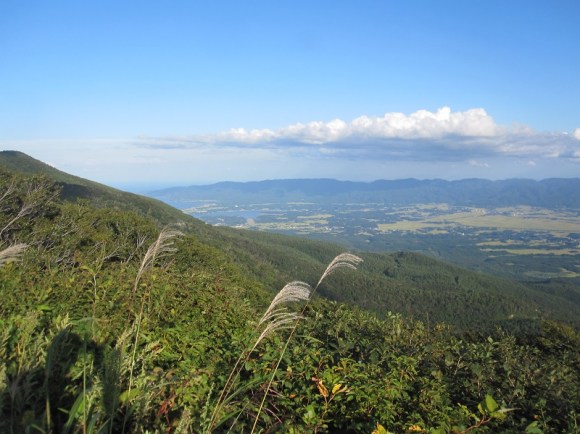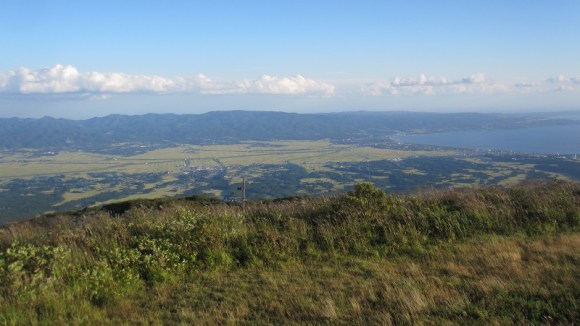
The tiny shaded part of each map represents half of the population.
Is Japan crowded? The answer really depends on where you go. On the one hand, Japan is the nation of comically packed rush hour commuter trains, but it’s also where you’ll find views like these.
Different parts of Japan have vastly different population densities, something that’s a result of both geographical and historical factors. The country’s mountainous topography has always limited where towns can be built, and during Japan’s protracted feudal era, restrictions on the flow of goods and people meant that resources clustered around the local warlord’s stronghold. Many of Japan’s present-day urban centers, including Tokyo, Osaka, Nagoya, and Hiroshima can trace their lineage back to a period of being a castle town, and even in the post-samurai age, they represent the greatest abundance of economic and educational opportunities.
To illustrate just how concentrated Japan’s population distribution is, Twitter users have taken to creating infographics that show a prefecture filled in with two colors, each representing half of the area’s residents. For example, Chiba Prefecture, Tokyo’s neighbor to the east, is home to some 6.2 million people, but half of them live just a stone’s throw away from the nation’s capital, in the area marked in red on the map below.
千葉県の人口2分割です pic.twitter.com/Wa254X585F
— みながれ (@Mina_akagi) November 25, 2016
North of Tokyo, you’ll find a pretty similar situation in Saitama Prefecture.
埼玉県を同じ人口で二分割するとこうなる
— LaTeX Glaceon(ラテグレ) (@latex_glaceon) November 25, 2016
っていうか、しゅうちゅうしすぎて、3分割になる pic.twitter.com/q5CGf676qT
Heading over to central Japan, Nara Prefecture has plenty of cool places to visit. Just about everyone wants to live at the north tip, though, in the prefectural capital of Nara City, which is linked by quick rail access to Osaka and Kyoto.
奈良県を、人口が(だいたい)等しくなるように2つに分割してみた pic.twitter.com/erX1EaYu7G
— らび (@ibaruyan) November 25, 2016
Another Osaka neighbor, Wakayama Prefecture, also has everyone wanting to find homes as close as possible to the border with the Kansai region’s largest city, located to Wakayama’s north.
https://twitter.com/ruta_q/status/802003291622080513Gifu Prefecture is seeing a huge influx of visitors coming to see the setting of some of anime hit Your Name’s most pivotal scenes, but most of the people who live there want to be situated close to Nagoya, across the prefectural line to the south in Aichi Prefecture.
https://twitter.com/ruta_q/status/802012993131155456Sometimes, though, a prefecture’s population gathers in its middle, like in Miyagi Prefecture, where capital city Sendai and neighboring municipality Natori together claim 50 percent of the prefectural population.
奈良県の人口2分割が話題になってるけど宮城県も大概だと思う pic.twitter.com/Gf25oXoL4X
— つくも (@kogasaLv96) November 25, 2016
And how does everything look when we zoom out to the national level? In the illustration below, those tiny blue areas represent half of Japan’s populace, with the scattered dark red spots accounting for an additional 25 percent, and the remaining quarter of the country’s residents spread out over the pink zones.
なんか人口二分割が流行ってるみたいなので全国版でやってみた。日本では青い部分に人口の半分が住んでいます。青い部分と濃い赤部分を合わせると人口の75%が住んでいます。青い面積は合わせると岩手県よりちょい広いくらいです。人口の集中っぷりが顕著ですね。 pic.twitter.com/dGMjn5tYwL
— Simon_Sin (@Simon_Sin) November 26, 2016
So really, most of Japan isn’t very crowded at all, as there are several points on the map where you’d have hardly any close neighbors at all. If you want to be near one of the big cities, though, well, let’s just say we hope you’re a people person, because you’re going to be dealing with a lot of them every day.
Source: IT Media, Twitter/@Simon_Sin
Top, insert image ©RocketNews24
Follow Casey on Twitter, where he feels like the population density in his part of Yokohama is just right.


 Crazy huge crowd of otaku, rockers, and sports fans forms at Japanese train station【Photos】
Crazy huge crowd of otaku, rockers, and sports fans forms at Japanese train station【Photos】 The crazy huge crowds of Summer Comiket【Photos, videos】
The crazy huge crowds of Summer Comiket【Photos, videos】 Daily horde of commuters into Tokyo is larger than one of history’s fiercest conquering armies
Daily horde of commuters into Tokyo is larger than one of history’s fiercest conquering armies Amazing castle photo ever shows why you shouldn’t skip this often-overlooked part of Japan
Amazing castle photo ever shows why you shouldn’t skip this often-overlooked part of Japan 7-Eleven Japan’s ramen-cooking robot whipped us up a bowl of noodles【Taste test】
7-Eleven Japan’s ramen-cooking robot whipped us up a bowl of noodles【Taste test】 Japan’s otoshidama tradition of giving kids money at New Year’s gets a social welfare upgrade
Japan’s otoshidama tradition of giving kids money at New Year’s gets a social welfare upgrade Can a dirty butthole make you filthy rich in Japan? We’re starting a New Year’s lottery experiment
Can a dirty butthole make you filthy rich in Japan? We’re starting a New Year’s lottery experiment Japan may add Japanese language proficiency, lifestyle classes to permanent foreign resident requirements
Japan may add Japanese language proficiency, lifestyle classes to permanent foreign resident requirements Hello Kitty Choco Egg figures are an adorable trip through three periods of Japanese pop culture【Pics】
Hello Kitty Choco Egg figures are an adorable trip through three periods of Japanese pop culture【Pics】 New smartphone game lets you date real-life J-pop idols, but shockingly gives them 100 Boyfriends
New smartphone game lets you date real-life J-pop idols, but shockingly gives them 100 Boyfriends More Than a Capsule Stay: Why Solo Travelers Choose “global cabin Yokohama Chinatown”
More Than a Capsule Stay: Why Solo Travelers Choose “global cabin Yokohama Chinatown” What the heck is okame soba?
What the heck is okame soba? Dragon Quest Burgers and Slime drinks are coming to McDonald’s Japan【Video】
Dragon Quest Burgers and Slime drinks are coming to McDonald’s Japan【Video】 Here’s what US$90 worth of katsu curry looks like at CoCo Ichibanya: A mountain of cutlets!
Here’s what US$90 worth of katsu curry looks like at CoCo Ichibanya: A mountain of cutlets! 7-Eleven Japan starts new temporary luggage storage service in over 300 branches
7-Eleven Japan starts new temporary luggage storage service in over 300 branches Disillusionment at Tsukiji’s tourist-target prices led us to a great ramen restaurant in Tokyo
Disillusionment at Tsukiji’s tourist-target prices led us to a great ramen restaurant in Tokyo Starbucks teams up with 166-year-old Kyoto doll maker for Year of the Horse decorations【Photos】
Starbucks teams up with 166-year-old Kyoto doll maker for Year of the Horse decorations【Photos】 Starbucks Japan releases new zodiac chilled cup drink for 2026
Starbucks Japan releases new zodiac chilled cup drink for 2026 Lacquerware supplier to emperor of Japan and Pokémon team up for new tableware
Lacquerware supplier to emperor of Japan and Pokémon team up for new tableware Tokyo’s Tsukiji sushi neighborhood asks tour groups to stay away for the rest of the month
Tokyo’s Tsukiji sushi neighborhood asks tour groups to stay away for the rest of the month Is this the most relaxing Starbucks in Japan?
Is this the most relaxing Starbucks in Japan? Starbucks on a Shinkansen bullet train platform: 6 tips for using the automated store in Japan
Starbucks on a Shinkansen bullet train platform: 6 tips for using the automated store in Japan Street Fighter Hadouken Churros to be launched and eaten in Tokyo, Okami pudding on offer too
Street Fighter Hadouken Churros to be launched and eaten in Tokyo, Okami pudding on offer too Japan’s human washing machines will go on sale to general public, demos to be held in Tokyo
Japan’s human washing machines will go on sale to general public, demos to be held in Tokyo Japanese train company is letting fans buy its actual ticket gates for their homes
Japanese train company is letting fans buy its actual ticket gates for their homes Tokyo considering law requiring more trash cans following litter increase in heavily touristed area
Tokyo considering law requiring more trash cans following litter increase in heavily touristed area Nintendo’s Kirby now delivering orders at Kura Sushi restaurants, but not in Japan
Nintendo’s Kirby now delivering orders at Kura Sushi restaurants, but not in Japan Tokyo event lets you travel back in time, for free, to celebrate 100 years since Showa era start
Tokyo event lets you travel back in time, for free, to celebrate 100 years since Showa era start Sanrio theme park in Japan announces plans to expand into a Sanrio resort
Sanrio theme park in Japan announces plans to expand into a Sanrio resort Survey asks foreign tourists what bothered them in Japan, more than half gave same answer
Survey asks foreign tourists what bothered them in Japan, more than half gave same answer Japan’s deadliest food claims more victims, but why do people keep eating it for New Year’s?
Japan’s deadliest food claims more victims, but why do people keep eating it for New Year’s? We deeply regret going into this tunnel on our walk in the mountains of Japan
We deeply regret going into this tunnel on our walk in the mountains of Japan Studio Ghibli releases Kodama forest spirits from Princess Mononoke to light up your home
Studio Ghibli releases Kodama forest spirits from Princess Mononoke to light up your home Major Japanese hotel chain says reservations via overseas booking sites may not be valid
Major Japanese hotel chain says reservations via overseas booking sites may not be valid Put sesame oil in your coffee? Japanese maker says it’s the best way to start your day【Taste test】
Put sesame oil in your coffee? Japanese maker says it’s the best way to start your day【Taste test】 The top 10 annoying foreign tourist behaviors on trains, as chosen by Japanese people【Survey】
The top 10 annoying foreign tourist behaviors on trains, as chosen by Japanese people【Survey】 No more using real katana for tourism activities, Japan’s National Police Agency says
No more using real katana for tourism activities, Japan’s National Police Agency says Starbucks Japan reveals new sakura drinkware collection, inspired by evening cherry blossoms
Starbucks Japan reveals new sakura drinkware collection, inspired by evening cherry blossoms Is this Japanese train crowded? Question divides the nation
Is this Japanese train crowded? Question divides the nation Commuter chaos at Shibuya Station after glass window breaks on door of crowded Japanese train
Commuter chaos at Shibuya Station after glass window breaks on door of crowded Japanese train What pandemic? Onsen towns, hiking trails and theme parks packed with crowds on four-day weekend
What pandemic? Onsen towns, hiking trails and theme parks packed with crowds on four-day weekend Amazing time-lapse-style video shows 150-year history of the growth of train stations in Japan
Amazing time-lapse-style video shows 150-year history of the growth of train stations in Japan Idol draws such massive crowds at Tokyo college that police can’t guarantee safety【Video】
Idol draws such massive crowds at Tokyo college that police can’t guarantee safety【Video】 And now, the story of a smelly fart on a crowded Japanese commuter train
And now, the story of a smelly fart on a crowded Japanese commuter train 10 tweets showing just how crazy snow can make things in Tokyo
10 tweets showing just how crazy snow can make things in Tokyo Massive blizzard creates crazy snow scenes in Sapporo【Photos, videos】
Massive blizzard creates crazy snow scenes in Sapporo【Photos, videos】 Infographic captures gamers’ frustration at DLC, but forgets some key points of video gaming past
Infographic captures gamers’ frustration at DLC, but forgets some key points of video gaming past
Leave a Reply